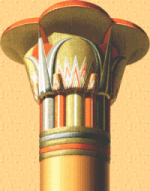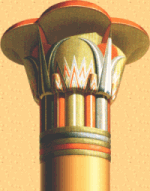 |


 The importance of one's name can never be over-emphasized. To be named, one must first breathe at least once, and thereafter a name would be given to complete his/her being. The responsibility of naming a child fell to the mother who bore it, maybe after consulting the father prior to labor. Often, that same name paid tribute to some thing or event, memorializing the circumstances in which the child entered the world. In the case of this child, perhaps her father's broadening plans had already founded a city; perhaps the birth had been extremely difficult; perhaps only Nefertiti knew why she thought of her third daughter as "Living Through the Aten"--Ankhesenapaaten.
The importance of one's name can never be over-emphasized. To be named, one must first breathe at least once, and thereafter a name would be given to complete his/her being. The responsibility of naming a child fell to the mother who bore it, maybe after consulting the father prior to labor. Often, that same name paid tribute to some thing or event, memorializing the circumstances in which the child entered the world. In the case of this child, perhaps her father's broadening plans had already founded a city; perhaps the birth had been extremely difficult; perhaps only Nefertiti knew why she thought of her third daughter as "Living Through the Aten"--Ankhesenapaaten.
Ankhes was born shortly after her sister Meketaten, maybe even within the same year. Her birth likely took place shortly before or after her father Akhenaten founded Akhetaten and made it Egypt's capital, a view strengthened by her pictoric absence in the Karnak Temples. At Amarna, her tiny figure was added as an afterthought to the margins of some of the Boundary Stelae; in one example a small statue of her was added to an existing statue group at the stelae's base by means of a tenon. Humble though these beginnings were, Ankhes joined her two elder sisters in being the most beloved and favored of the princesses. In family reliefs, she is most often found cuddling with her mother, an affectionate hand stroking Nefertiti's cheek or mischieviously reaching toward an earring or spangle. Ankhes has the added distinction of being the only Princess whose menat (nurse) is known by name: a talatat block in the Metropolitan Museum reveals her to be "The Nurse of the King's Daughter Ankhesenapaaten, Tia." Occasionally, the princesses did manage to escape the attention of Tia and her companions; their playroom in the Amarna palace bears many a yellow, red, blue, and green paintmark on the floor and lower sections of the walls. Along with their scribbles, the princesses also left behind their paint brushes.
 Splendid (and spoiled:) as her childhood was, the course of Ankhesenapaaten's upcoming adult life was far less certain. Her two elder sisters outranked her by birth and thus stood a likelier chance of becoming Queen, which for Meritaten was a certainty. The death of Meketaten in Year 13 or 14 was a sad end for her and her anonymous child, but it also marked the beginning of her younger sister's rise in favor. By filling the void left by her elder sibling, Ankhes was only a step behind Meritaten, the oldest of the girls and the family favorite. Akhenaten soon elevated Mayati to the position of queen, and eventually they had a daughter, Meritaten-Tasherit. When Meritaten became the wife of Smenkhkare, her father's successor, Akhenaten needed a new queen; his third daughter thus replaced his first. Ankhes, too, came to be with child, another daughter. Named after her mother, Ankhesenapaaten-Tasherit does not seem to have lived long after birth, as mentions of her are not only few, but incomplete. Even so, the little princess was not to be her mother's only child, just as Akhenaten was not her only husband. She may also have married Smenkhkare shortly before his death, Meritaten having died beforehand.
Splendid (and spoiled:) as her childhood was, the course of Ankhesenapaaten's upcoming adult life was far less certain. Her two elder sisters outranked her by birth and thus stood a likelier chance of becoming Queen, which for Meritaten was a certainty. The death of Meketaten in Year 13 or 14 was a sad end for her and her anonymous child, but it also marked the beginning of her younger sister's rise in favor. By filling the void left by her elder sibling, Ankhes was only a step behind Meritaten, the oldest of the girls and the family favorite. Akhenaten soon elevated Mayati to the position of queen, and eventually they had a daughter, Meritaten-Tasherit. When Meritaten became the wife of Smenkhkare, her father's successor, Akhenaten needed a new queen; his third daughter thus replaced his first. Ankhes, too, came to be with child, another daughter. Named after her mother, Ankhesenapaaten-Tasherit does not seem to have lived long after birth, as mentions of her are not only few, but incomplete. Even so, the little princess was not to be her mother's only child, just as Akhenaten was not her only husband. She may also have married Smenkhkare shortly before his death, Meritaten having died beforehand.
By the time of the reigning Pharoah's passing--be he Smenkhkare or Akhenaten--Ankhesenapaaten had already endured much in her short life: one--possibly two--queenships, the birth and death of a child, and the demise of the majority of her immediate family. The one monument at Amarna meant to honor her was a Sunshade Temple usurped from another queen--"The King's Favorite" Kiya--and shared with Meritaten. At thirteen, Ankhes was now to be wed to the only heir remaining: the prince Tutankhaten. She was three years his senior and outranked him by virtue of her fully royal blood, but such differences were not so significant as maintaining the succession. She and her husband were all that remained of true Amarna.
The influence of the Aten had depended on the influence of its one true son and profit; Akhenaten's death cloaked the brightness with a veil not to be lifted, but pulled down furth by the political changes that moved Ankhes and Tutankhaten from Akhetaten after only two years on the throne. The capital was moved back to Memphis. Left behind was the palace, the members of their family within the royal tomb, and their given names. Ankhesenamun and Tutankhamun set off for Upper Egypt and their new lives. Akhetaten would abandon itself.
Memphis was to shelter the king and queen; they, in turn, sheltered one another. The constant shadows of their advisors must have made any truly private moments as precious as the love furthered and made. The next prince or princess--and the future of the Dynasty--was now growing within Ankhes' womb.
The birth of her first child had occurred when she was not yet a teenager; the physical immaturity that was
the death of Meketaten certainly did not leave Ankhes' growing body unaffected. Eight months into her second pregnancy, Ankhesenamun miscarried. Had the little girl lived, she would have suffered from spina bifida and other ails, but it is doubtful that her parents cared about the deformity. There were only her delicate features, a sweet countenance known only too briefly by her parents before it was left to the embalmers' art.
The queen's next pregnancy brought with it as much trepidation as happiness, and certainly far more throe when Ankhes again miscarried. At five months gestation, the fetus had only recently developed into a discernable female. The sad, drawn nature of her gray face expressed the tragedy to perfection.
Ankhesenamun had lost so much, and stood to loose far more. Near the end of his tenth regnal year, Tutankhamun died. Shrieks of mourning resounded throughout the palace and surrounding countryside, continuing to reverberate within the chambers of Ankhes' heart and mind.
The mummification of her husband's body would require seventy days; within that time her future would be decided. Ankhes had the misfortune of being the only fully royal family member left, and she knew well that this made her vulnerable to those who wished to possess Egypt's empty throne. If she moved quickly, prudently, and-- most of all--covertly, she could decide just how invulnerable and unavailable she could make herself.
My husband died. A son I have not. But to thee, they say, the sons are many. If thou wouldst give me one son
of thine, he would become my husband. Never shall I pick out a servant of mine and make him my husband. I am afraid!
To have written thus to the Hittite King was not only risky, it was treason. But Ankhesenamun was desperate, and in no way wished to give the feared "servant"--General Horemhab--the Double Crown. She must have had immense support within court circles, otherwise the delivery of her letters and their replies would not have been possible. Had King Suppilimias known this, he may not have been so doubtful as to send a chamberlain to Egypt to verify the queen's odd request. Ankhes' distress at welcoming a chamberlain instead of a prince was obvious, the same anger and increasing panic permeating her next letter.
Why didst thou say 'they deceive me,' in that way? Had I a son, would I have written about my own and my country's shame to a foreign land? Thou didst not believe me and hast even spoken thus to me! He who was my husband has died. A son I have not. Never shall I take a servant of mine and make him my husband! I have written to no other country, only to thee have I written. They say thy sons are many: so give me one son of thine! To me he will be husband, but in Egypt he will be king.
A prince, Zinanza, was duly sent. At last, she had been believed!
She had also been found out. Zinanza never reached either the capital or his prospective bride; he had barely crossed Egypt's border when splashes of crimson marked the place of his assasination. The queen's last hope was gone.
Or was it? Perhaps the prince and the letters asking for him were nothing more than a shrewd ruse on behalf of Ankhesenamun and her supporters meant to get General Horemhab away from the capital and the throne whilst he and his forces squelched the trespassing Hittites. Whatever the reasons for the letters, by the time of Horemhab's return Tutankhamun had already been laid to rest by his successor, the God's Father Ay. The General's absence allowed him to make all the (hasty) burial arrangements as well as perform the Opening of the Mouth Ceremony on his predecessor, both of which would secure his place as the next Pharaoh. Further security was garnered by marrying Ankhesenamun. Fiance rings were commissioned to commerate the union and are also the only and most compelling evidence that it took place. Nestled together though their cartouches are on the one surviving ring, Ay's is the only one of the pair that appears in his tomb. Shown with him is not Ankhes, but his wife Tiy, who has been his companion since before Ankhesenamun's birth. Ay barely reigned for four years; Ankhes would have been twenty-six at the time of his death. Yet it is not she who lends dynastic credance to Egypt's next pharaoh--Horemhab--but Mutnodjmet, Nefertiti's sister. The last of the Amarna princesses is nowhere to be found, and in all probability died some time before.
There is no record of Ankhesenamun's death, nor any known tomb. Recent age estimates on the mummy
identified as that of Queen Tiye have placed the woman's age at death in the early 30's to 40's range, encouraging theories that "Tiye" is actually Ankhes. Age estimates based on bone-development are to be taken with caution, however, and the well-worn teeth of the Elder Woman are indicative of an older individual, one too old to be Ankhesenamun. Where, then, is her mummy? Her burial? Because of her attempts to crown a Hittite King, neither body or chamber may have ever existed.
But ... she was the queen of three pharaohs, believer and surivivor of Amarna, a mother, a beauty ... she and her legacy deserve a place to rest.



|
 |